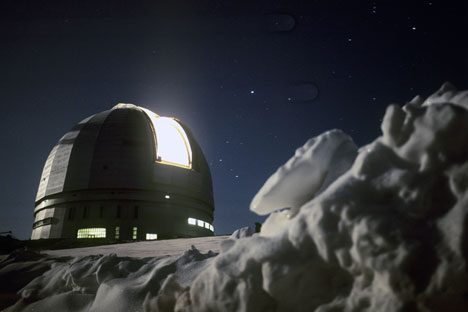
The Large Azimuth Telescope is still one of the 20 largest in the world. Source: RIA Novosti
To be an astronomer is to be a member of a very select group. Only 50 new astronomers graduate from Russian universities every year. But as many as 100 people who share this rare profession live in the tiny village of Nizhniy Arkhyz, situated in a picturesque valley and surrounded by the Caucasus mountains and ancient temples. The oldest scientist in the group, Yury Glagolevsky, is 82.
The village has such a high concentration of scientists because it is located just over 10 miles from the Large Azimuth Telescope (LAT), one of the biggest in the world. Only 30 people have ever actually gazed through that telescope at the stars.
Yury Balega, the head of the telescope facility, said that the work of an astronomer is not just stargazing.
“The times of Galileo are long gone,” Balega said, “These days, all the information collected by the telescope is fed to a computer. The job of the astronomers is to process and interpret that data. That work can take months, even years. Huge amounts of data are constantly being exchanged, so astronomers work as parts of a team - usually an international team. A single academic paper can have up to 10 authors."
Is there life in a telescope?
Despite the slow pace of work, life at the LAT facility is fairly comfortable. In addition to recreation facilities and a nice cafeteria, breathtaking views of snowy mountain peaks open from every window. There is, however, one major drawback. Every morning, at 8 a.m. sharp, the astronomers are woken up by tourists. The facility hosts up to 500 visitors each day – no small feat for a location more than 9,000 feet above sea level.
In the 1970 and 1980s, when the LAT was still the largest telescope in the world, Nizhniy Arkhyz hosted numerous science conferences. Leading astronomers from all over the world would gather at the telescope facility. Despite the prestige, Balega says that the life of a Soviet astronomer was not easy.
“Observations would start at 5 p.m., and continue until 7 a.m.,” Balega said. “The scientist would sit in a tiny cabin at the very top of the telescope. The visor of the telescope would slowly slide sideways, opening up a breathtaking view of the sky. That view was absolutely stunning! But it was extremely cold, sitting there at the top. We had to wear a special heated costume we called 'the penguin.'
We would spend 14 hours at a time in that cabin; we couldn’t leave until the whole telescope assembly was lowered. We couldn’t move in that cabin, either, because our movements would send tremors across the entire telescope assembly, blurring the image of the stars on the photo plate. And leaving the cabin early was simply out of the question."
Today, astronomers rarely have a minute to themselves during the workday.
“My day at work starts by reading new papers by colleagues from all over the world,” said Sergei Fabrika, who works at the LAT. “On average, 50 new papers are published in our field every day. I can sometimes spend the whole day analyzing a particularly interesting article. I then process fresh data from the telescope. After that, I meet students and post-graduates. The reason I have any time to myself during the day is that the journey from work to home is a three-minute walk, so usually I have an hour to play badminton.”
Other astronomers take advantage of a ski slope next to the telescope building. Balega, for his part, begins every single day with a jog and a swim in the river, regardless of the weather.
To see the edge of the universe
The astronomers from Karachayevo-Cherkessia specialize in black holes. They are among the top international specialists in this field. A group of scientists there, led by Yury Pariysky, has discovered a gigantic black hole in the RC J0311+0507 galaxy, which is 12.3 billion light years away from Earth.
The Large Azimuth Telescope is still one of the 20 largest in the world, and scientists from all over the planet book time on it. Astronomers from Germany, France and the United States have several ongoing joint projects with the scientists in Karachayevo-Cherkessia.
“Many wonderful discoveries have been made at the LAT,” Balega said. “It is powerful enough to see galaxies some 13 billion light years away, which is right at the edge of the universe.”
Scientists at the observatory have learned to determine the mass of giant stars, whose birth and evolution are still a subject of heated debates among astrophysicists.
“Star mass is one of the most difficult parameters to measure,” said Fabrika. “But if we know a star’s mass, we can predict the likelihood of its turning into a black hole or a neutron star. We can tell whether it will eventually become a White Dwarf, like our own Sun, or blow up as a supernova."
According to Yury Balega, observations made at the LAT could have far-reaching consequences that the scientists making them might never consider. “Science is a constant process of discovery,” Balega said. “Having understood how the Sun works, scientists were able to build the hydrogen bomb. Once we have understood the nature of other celestial bodies, we may well discover new sources of energy, or learn the secrets of unseen dark matter.”
All rights reserved by Rossiyskaya Gazeta.
Subscribe
to our newsletter!
Get the week's best stories straight to your inbox